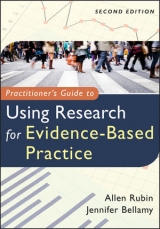
Practitioner's Guide to Using Research for Evidence Based Practice
John Wiley & Sons Ltd (Verlag)
978-0-470-13665-2 (ISBN)
- Titel erscheint in neuer Auflage
- Artikel merken
Written by a top scholar in the field, Practitioner's Guide to Using Research for Evidence-Based Practice gives essential and practical guidance on how to integrate research appraisal into evidence-based practice endeavors to ensure the best client care. This reader-friendly book presents you with the knowledge you need about various research designs and methods so that when engaging in the evidence-based practice (EBP) process, you can determine which interventions, programs, policies, and assessment tools are supported by the best evidence.
ALLEN RUBIN, PhD, teaches in the School of Social Work at the University of Texas, Austin. He is world-renowned for his work in research methods and clinical practice and served as president of the Society of Social Work and Research from 1998-2000. He is the recipient of the Council on Social Work Education 2007 Significant Lifetime Achievement in Social Work Education Award.
Preface xiii Acknowledgments xix PART I OVERVIEW OF EVIDENCE-BASED PRACTICE Chapter 1 Introduction to Evidence-Based Practice 3 Emergence of Evidence-Based Practice 5 Defining Evidence-Based Practice 6 Evidence-Based Practice Is Not Restricted to Clinical Decisions 11 Developing an Evidence-Based Practice Process Outlook 11 Easier Said than Done 15 Key Chapter Concepts 16 Review Exercises 17 Additional Readings 18 Chapter 2 Steps in the EBP Process 19 Step 1: Question Formulation 19 Step 2: Evidence Search 20 An Internet Search Using Google Scholar and PsycINFO 23 Step 3: Critically Appraising Studies and Reviews 27 Step 4: Selecting and Implementing the Intervention 28 The Importance of Practice Context: A Policy Example 29 Step 5: Monitor Client Progress 32 Feasibility Constraints 32 Key Chapter Concepts 35 Review Exercises 36 Additional Readings 37 Chapter 3 Research Hierarchies 38 More Than One Type of Hierarchy for More than One Type of EBP Question 39 Qualitative and Quantitative Studies 41 Types of EBP Questions 42 Key Chapter Concepts 56 Review Exercises 57 Additional Readings 58 PART II CRITICALLY APPRAISING STUDIES FOR EBP QUESTIONS ABOUT INTERVENTION EFFECTIVENESS Chapter 4 Criteria for Inferring Effectiveness 61 Internal Validity 62 Measurement Issues 68 Statistical Chance 72 External Validity 78 Synopses of Research Studies 80 Key Chapter Concepts 82 Review Exercises 83 Additional Readings 84 Chapter 5 Critically Appraising Experiments 85 Classic Pretest-Posttest Control Group Design 86 Posttest-Only Control Group Design 89 Solomon Four-Group Design 90 Alternative Treatment Designs 92 Dismantling Designs 93 Placebo Control Group Designs 94 Experimental Demand and Experimenter Expectancies 96 Obtrusive versus Unobtrusive Observation 98 Compensatory Equalization and Compensatory Rivalry 98 Resentful Demoralization 99 Treatment Diffusion 99 Treatment Fidelity 101 Practitioner Equivalence 101 Differential Attrition 103 Synopses of Research Studies 105 Key Chapter Concepts 107 Review Exercises 108 Additional Readings 109 Chapter 6 Critically Appraising Quasi-Experiments: Nonequivalent Comparison Groups Designs 110 Nonequivalent Comparison Groups Designs 111 Additional Logical Arrangements to Control for Potential Selectivity Biases 113 Statistical Controls for Potential Selectivity Biases 118 Pilot Studies 123 Synopses of Research Studies 126 Key Chapter Concepts 128 Review Exercises 128 Additional Readings 129 Chapter 7 Critically Appraising Quasi-Experiments: Time-Series Designs and Single-Case Designs 130 Simple Time-Series Designs 131 Multiple Time-Series Designs 134 Single-Case Designs 135 Synopses of Research Studies 144 Key Chapter Concepts 148 Review Exercises 149 Additional Reading 150 Chapter 8 Critically Appraising Systematic Reviews and Meta-Analyses 151 Advantages of Systematic Reviews and Meta-Analyses 152 Risks in Relying Exclusively on Systematic Reviews and Meta-Analyses 154 Where to Start 154 What to Look for When Critically Appraising Systematic Reviews 155 What Distinguishes a Systematic Review from Other Types of Reviews? 161 What to Look for When Critically Appraising Meta-Analyses 162 Synopses of Research Studies 174 Key Chapter Concepts 176 Review Exercises 178 Additional Readings 178 PART III CRITICALLY APPRAISING STUDIES FOR ALTERNATIVE EBP QUESTIONS Chapter 9 Critically Appraising Nonexperimental Quantitative Studies 181 Surveys 182 Cross-Sectional and Longitudinal Studies 193 Case-Control Studies 195 Synopses of Research Studies 197 Key Chapter Concepts 201 Review Exercises 203 Additional Readings 203 Chapter 10 Critically Appraising Qualitative Studies 204 Qualitative Observation 205 Qualitative Interviewing 208 Qualitative Sampling 211 Grounded Theory 212 Frameworks for Appraising Qualitative Studies 213 Synopses of Research Studies 218 Key Chapter Concepts 223 Review Exercises 227 Additional Readings 228 PART IV ASSESSING CLIENTS AND MONITORING THEIR PROGRESS Chapter 11 Critically Appraising and Selecting Assessment Instruments 231 Reliability 232 Validity 236 Sensitivity 241 Feasibility 244 Sample Characteristics 245 Locating Assessment Instruments 246 Synopses of Research Studies 248 Key Chapter Concepts 250 Review Exercises 252 Additional Readings 252 Chapter 12 Monitoring Client Progress 253 A Practitioner-Friendly Design 255 Feasible Assessment Techniques 258 Summary 268 Looking Ahead 270 Key Chapter Concepts 272 Review Exercises 273 Additional Reading 273 Appendix A Critical Appraisals of Study Synopses at the End of Chapter 4 274 Appendix B Critical Appraisals of Study Synopses at the End of Chapter 5 277 Appendix C Critical Appraisals of Study Synopses at the End of Chapter 6 280 Appendix D Critical Appraisals of Study Synopses at the End of Chapter 7 283 Appendix E Critical Appraisals of Study Synopses at the End of Chapter 8 285 Appendix F Critical Appraisals of Study Synopses at the End of Chapter 9 288 Appendix G Critical Appraisals of Study Synopses at the End of Chapter 10 292 Appendix H Critical Appraisals of Study Synopses at the End of Chapter 11 295 Glossary 299 References 313 Index 319
| Erscheint lt. Verlag | 11.12.2007 |
|---|---|
| Zusatzinfo | Illustrations |
| Verlagsort | Chichester |
| Sprache | englisch |
| Maße | 185 x 257 mm |
| Gewicht | 784 g |
| Einbandart | gebunden |
| Themenwelt | Geisteswissenschaften ► Psychologie |
| Medizin / Pharmazie | |
| Sozialwissenschaften ► Pädagogik ► Sozialpädagogik | |
| Sozialwissenschaften ► Soziologie ► Empirische Sozialforschung | |
| ISBN-10 | 0-470-13665-0 / 0470136650 |
| ISBN-13 | 978-0-470-13665-2 / 9780470136652 |
| Zustand | Neuware |
| Haben Sie eine Frage zum Produkt? |
aus dem Bereich



